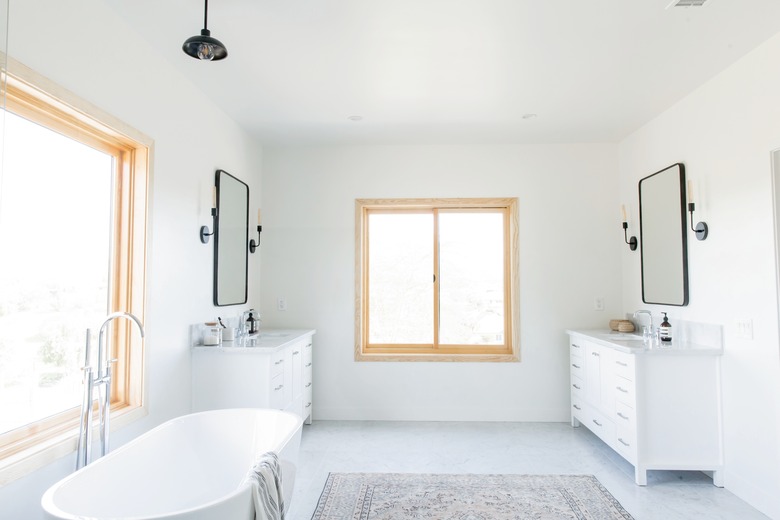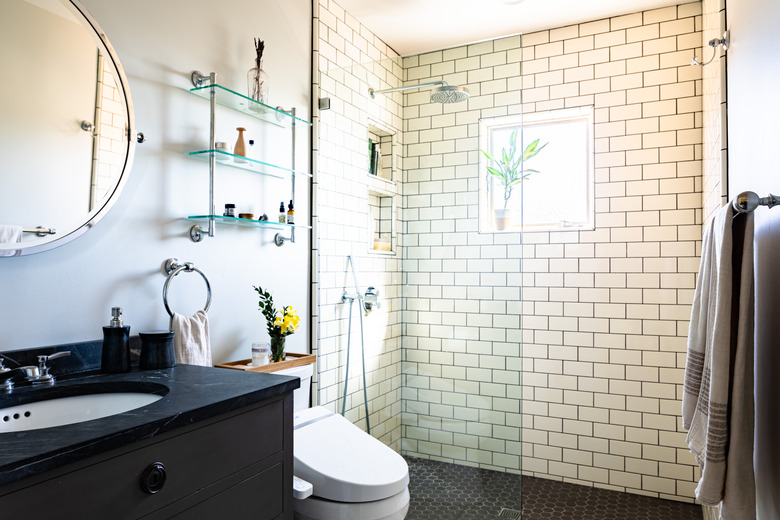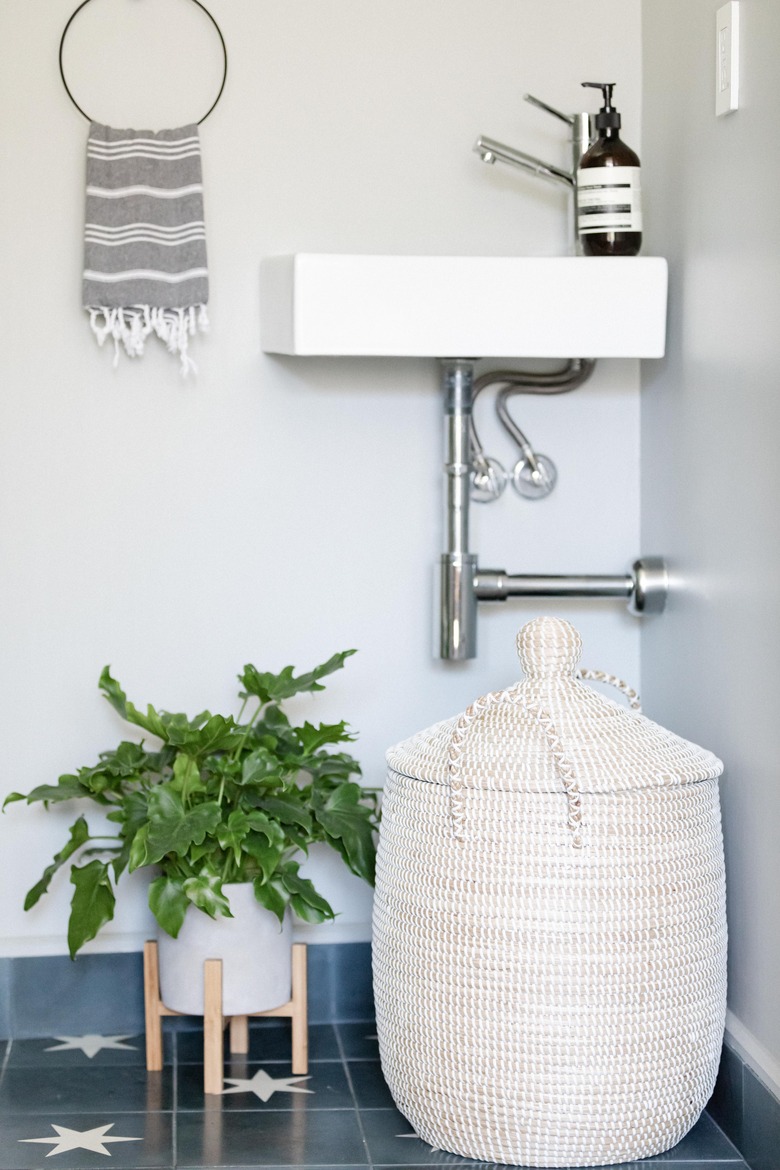How Much Does A Bathroom Designer Cost?
When homeowners put together a budget for their bathroom remodeling project, they often ask, "How much does a bathroom designer cost?" It's not an idle question. The components of this home improvement project add up quickly, and they wonder whether a designer is really needed for such a small space.
The short answer is "yes," at least most of the time. Despite their relatively small size, bathroom renovations are very complex projects that often require an experienced design pro.
Tip
Designers' fees vary based on their involvement with the bathroom renovation project. Hourly rates for design-only participation range from $100 to $300. If the designer designs the project and manages construction, it will cost 10 percent to 20 percent of the project cost.
Design-Only Fees for Bathroom Renovation
Design-Only Fees for Bathroom Renovation
A bathroom designer works with you to put your ideas and needs for a new bathroom into an actionable concept. Together, you and the designer develop a plan that guides the remodeling. How much a bathroom designer costs depends on how involved he or she becomes with the project.
For a consult meeting where the designer offers suggestions on general design and advice on products, such as sinks and faucets, cabinetry and finishes, the national average is $200 to $400. It's best that this meeting takes place in your home so the designer can see the space that will be remodeled. If it can't, try to bring a drawing of the existing bathroom to the meeting.
An independent designer — one who is self-employed and not affiliated with a remodeling company — may charge $100 to $300 per hour. Hourly billing includes actual design work as well as phone calls, meetings and the like. If a designer charges a flat design fee, expect to pay $2,500 to $3,500 for the plan. This arrangement often includes a limit on the number of hours worked or the number of revisions to the plan. Extra work will include an extra charge.
Remodeling contractors and design/build firms have designers on staff. The staff designers are part of the team that will handle the project from start to finish. How much the bathroom designer costs is part of the overall fee the firm charges you, which will include design and labor costs. Home centers have designers on staff who can help you create a plan and pick out products. There may be a small fee, but the fee is usually rolled into the overall project cost if the home center does the remodeling work.
Design-Plus Fees for Bathroom Renovation
Design-Plus Fees for Bathroom Renovation
Some designers not only provide the building plans for the project but also specify and purchase materials and products like vanities, countertops, sinks and other fixtures. This ensures that everything is the correct size, and the items will most likely be on-site when they are scheduled to be installed. In some cases, you will be working with the designer to pick items from sample books, but many designers like to accompany their clients to product showrooms to make the selections.
An advantage of working with a designer to purchase products is that professionals usually have access to products that are not available to the general public. Some designers charge a flat fee of $1,000 to $2,500 for researching and specifying products. Others use a cost-plus-markup arrangement. They buy the product at a wholesale price and then add a markup value.
In many cases, independent designers do not have much to do with the construction process, but some will visit the site occasionally to make sure the project is following the design. Sometimes, this service is part of the original contract, but if not, the designer may charge $100 to $150 per visit.
Designer as Construction Manager
Designer as Construction Manager
The person who designs your new bathroom may also be the general contractor (GC) for the project. The GC orders materials and products, hires subcontractors, secures the necessary building permits, schedules the various trades involved and arranges for the building inspections. GCs are also responsible for paying all of the bills. Designers in this category are often owners or part owners of the remodeling firm.
GCs rarely charge a flat fee, but they figure 10 percent to 20 percent of profit for themselves in the estimate they give you. Because their profit depends on everything going according to plan, they are good at keeping the project on schedule.
Working with a designer who is the GC means the construction crew can't blame the designer and vice versa when there is a problem. It also means that you have only one contact if you have a question or problem with the project.
Do You Need a Bathroom Designer?
Do You Need a Bathroom Designer?
Simple projects such as replacing the toilet and vanity with new ones probably don't require a professional designer and are appropriate for DIY. However, changing the floor plan, expanding the room and major replacements, such as removing the old tub and replacing it with a large custom shower, call for a designer's help.
Designers are trained to conceptualize how a space can be best arranged. They also know what is trending and what styles are timeless. They can help you pick materials and products, and they can suggest items and techniques you may never have heard of before. A local designer is often connected with local tradespeople and suppliers and can point you to the people and companies that can help you get the bathroom you want.
Designers are trained to work within a set budget. They can keep the project on track by suggesting alternative items for expensive features that might blast the budget apart. Should a problem arise, and they often do in bathroom remodeling, a designer who is still part of the project can help find a reasonable solution.
Finding a Bathroom Designer
Finding a Bathroom Designer
In most places, the plumber, electrician and contractor you hire will probably be licensed by the state, but the designer may or may not be licensed. In any case, hiring a qualified designer is the first step to a successful project. To find leads, you can contact the National Kitchen and Bath Association (NKBA).
The process is similar to finding any pro you would hire — check references and view past projects. It is also important to get a feel for the style of the designer and to make sure you are comfortable working with that person. Huddling with a designer who is creating a new space for you is a little more intimate than hiring a plumber.
The NKBA has a certification program for designers. It is not necessary for a designer to be certified in order to produce great bathrooms, but those who are certified have gone through a process that includes hands-on experience and classroom training.
To qualify to become a certified kitchen and bath designer, designers must have five years of industry experience and 60 hours of NKBA courses or approved college courses. Course work includes bath planning, materials and products, lighting and project management. An advanced certification — certified master kitchen and bath designer — is also available.


